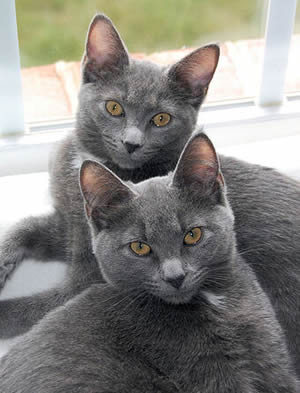Breed Standard
Head: Heart-shaped when seen from the front. Flat forehead. Slight stop between the forehead and nose. Firm, well-developed cheeks. Muzzle neither pointed nor angular. Long nose, slightly domed at the tip. Strong, well-developed chin. Strong jaws.
Eyes: Large, round, well-spaced, slightly slanted. Preferably luminous green in color. Amber eyes are accepted, especially in young cats. Actually, the final color is not attained before the age of two. Eyebrows form two broad curves above the eyes.
Neck: Medium-sized, long.
Body: Medium-sized, semi-cobby, neither compact nor svelte. Slightly arched back. Strong, muscular, flexible.
Paw: Hind legs slightly longer than forelegs. Medium to heavy bone structure. Oval paws
Tail: Moderately long, thicker at the base, tapering to a rounded tip.
Coat: Short, fine, lustrous, dense hair. Simple coat (no undercoat) tending to stand erect on the spine when the cat is in motion. Even, silver blue color. The tip of the hair is silver, making the coat appear frosted. The nose leather is dark blue-gray. Paw pads dark blue to pinkish lavender.
Fault: Narrow head. Small, closely spaced eyes. Yellow eyes. Nose too long or too short. Pinched chin. Disqualify: any color other than blue. White markings.
History
This independent gray cat brings good luck This natural breed originated in Thailand, where it was first established in the 14th century. It is named after a province in Thailand, where it is considered a bearer of good luck. In fact, its original name, Korat, means culture and prosperity. In The Cat Book of Poems of the Ayutthaya kingdom (1350-1767), this cat is said to have "eyes that shine like dewdrops on a lotus leaf". Specimens were imported and shown in Great Britain in the late 19th century, but without success, since they were seen simply as Siamese cats with blue coats. American breeder Jean Johnson began breeding Korats in 1959. The breed was recognized by the C.F.A. in 1966 and by T.I.C.A. in 1969. Upon its arrival in Europe in 1972, the Korat was approved by the F.I.Fe. Well-known in the United States, the breed is quite uncommon in Europe.
Behavior
The Korat is lively, active, very agile and playful but does not like agitation or noise. He needs a tranquil environment. Korats are not very friendly toward other cats and are reserved toward strangers. Gentle, very affectionate, and hypersensitive, they are highly attached to their owner. They need lots of love and attention. They have a melodious voice. They are easy to groom, as weekly brushing is sufficient.
Health
Extreme Sensitivities to Anesthetics, Vaccines, and Pesticides, Respiratory Infections have been seen in the breed.






